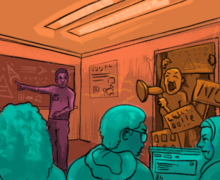Workers’ Center of Central New York empowers immigrants through storytelling
Solange Jain | Asst. Photo Editor
Jessica Maxwell (left) and Víctor María Chamán (right) sit in front of a bulletin board in Chamán’s office. The board keeps track of all of the immigrant storytellers included in their project.
Get the latest Syracuse news delivered right to your inbox.
Subscribe to our newsletter here.
Jessica Maxwell and Víctor María Chamán both started out as volunteers for the Workers’ Center of Central New York, not expecting to join the organization full-time.
But now, Maxwell works as the center’s executive director, while Chamán is the writer-in-residency. This year, they hope to continue spotlighting central New York’s immigrant community through storytelling. In doing so, the organization hopes to challenge the negative political narratives that have been prominent in the 2024 United States election cycle, they said.
At a Sept. 10 U.S. presidential debate between former President Donald Trump and Vice President Kamala Harris, Trump falsely accused Haitian immigrants of eating cats and dogs in Ohio. Trump has repeated anti-immigrant sentiments during his campaign, and immigration policies have been at the forefront of multiple political races throughout the country.
“All these narratives of immigration play a huge role in the national conversation, but in terms of people’s daily lives and how they interact with immigrants, I don’t know that it really reflects those narratives,” Maxwell said.
Founded in 2006, WCCNY aims to empower low-wage workers through leadership development initiatives, like training sessions about workers’ rights and occupational health and safety, according to its website. The center supports policies to increase wages and improve workplace standards, especially in areas with high poverty rates.
In central New York, the majority of jobs in lower-wage sectors are filled by immigrant workers, Maxwell said. According to the Immigration Research initiative, 35% of immigrants in the U.S. work in jobs paying under $35,000 a year. Immigrant status often creates obstacles in work environments, including language barriers, access to transportation and work visas or other documentation.
Before she came to WCCNY, Maxwell grew up on a small family farm in New York state and has worked in Syracuse’s community service sector for the last 20 years, she said. She initially took on a limited role at WCCNY because she felt that, as a white woman, she wasn’t representative of the community the organization serves, she said.
But when the spot opened up, she eventually stepped into the role of executive director, which she felt was a good fit due to her years of volunteering experience and bilingual Spanish background.
A significant part of Maxwell’s role at WCCNY is meeting with workers to share information about its initiatives and hear about their working conditions. From there, she helps workers look into available support resources.
“A lot of people work in isolation, (which) just means people don’t have a lot of time to go out and seek information, to engage in the communities, and so that outreach is a really key piece,” Maxwell said.
While Maxwell focuses on the administrative aspects of WCCNY, Chamán has focused on the organization’s ongoing storytelling project, which will highlight the voices and stories of local immigrants.
All these narratives of immigration play a huge role in the national conversation.Jessica Maxwell, WCCNY executive director
Chamán is originally from Torreón, Mexico, and moved to the U.S. when he was 19 years old, he said. He then came to Syracuse University to study under Professor George Saunders and Trustee Professor Mary Karr, both in SU’s English department. He graduated in 2023 with a Master of Fine Arts in creative writing.
Creatives Rebuild New York hired Chamán as a part of its Artist Employment Program in July 2022. The program funds employment for up to 300 artists and “culture bearers” in collaboration with several community-based organizations across New York State. Through the program, Chamán receives the necessary funds to pursue projects.
Along with his work at CRNY, Chamán and WCCNY began the collaborative artistic project to amplify the voices of the state’s immigrant population. Still in its early stages, the project does not yet have a finalized title, Chamán said.
The project contains stories from around 50 immigrants in the state of New York, from Montauk to Buffalo. It encompasses a variety of topics, including love, business and religion, he said, and will also include biographical accounts.
“Sometimes, the demographics of being Latin or an immigrant are really beside the point. Ultimately, this is a book of strangers,” Chamán said.
Like most grassroots organizations that focus on political goals, WCCNY weaves testimony into its work. But Chamán said people’s perspectives and their testimonial contributions often fade with time, like political campaigns.
The project aims to be the complete opposite of the traditional testimony model, Chamán said. Instead, Chamán and Maxwell hope for storytellers to talk about whatever they want for however long they want, with their stories staying separate from the group’s political motivations.
The project compensates participants for telling their stories through gift cards, meals or direct payments.
With immigration at the forefront of national debates ahead of the election, WCCNY hopes that the stories it tells can flip negative or false narratives.
“One of the things that’s interesting to me is if you read the stories, there’s no way you can hold on to those narratives while you see these stories. It just doesn’t fit the framework and doesn’t make sense,” Maxwell said.
CORRECTION: A previous version of this post misstated Víctor María Chamán’s title. He is the writer-in-residency at the center. The Daily Orange regrets this error.
Published on October 10, 2024 at 12:43 am
Contact Madeline: mmgoodhe@syr.edu






